Today we’ll talk about Scythe Kaze Master Ace 5.25’’, a device used for controlling the fan speed. Many of you know about Kaze Master Ace 5.25’’ or the slightly older version of it, the Kaze Master 5.25’’. Both of these controllers are on the market for over a year now, but the efficiency and the nice looks still make them pretty popular. These devices are always in demand and we must say that it made our lives a whole lot easier.
You can use Kaze Master Ace 5.25’’ to simultaneously control up to 4 fans, where each fan is monitored via an easily accessible vacuum fluorescent display (VFD). As you can tell from the name, 5.25’’ means that the controller is mounted in the front 5.25’’ front panel slot. The display is clear and visible no matter the angle you’re viewing it from.
Kaze Master Ace 5.25’’ also features four temperature sensors and will display the readings on the display. The sensors are at the end of 70cm cable, making even the farthest components easy to reach.
Kaze Master Ace comes in two versions, one for 5.25’’ and the other for 3.5’’ slot. The smaller one allows for controlling two fans and has two temperature sensors.
As we’ve learned to expect from Scythe, the package features a bunch of info and details on the controller. The info shows that the fans can be controlled independently and that the device will measure temperatures in four locations with readings in Celsius or Fahrenheit. It also comes with an acoustic alarm which goes off if the temperatures exceed a certain threshold (75°C) or the fans stop spinning.
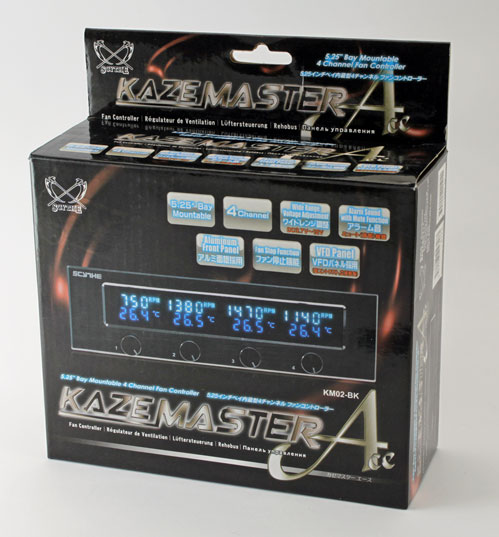
On the back of the box you’ll find a list of Kaze Master Ace’s connectors and the left side features specs.
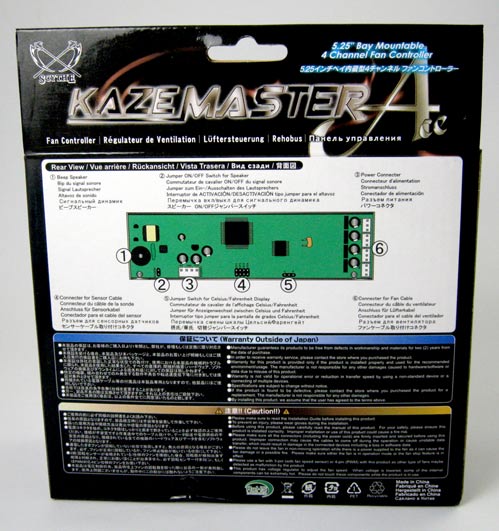
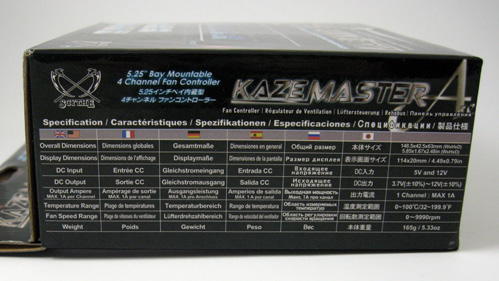
In the box you’ll find everything you need for hassle free installation. The fan extension cords are 71cm long and are marked with numbers from 1 to 4. Naturally, it doesn’t matter in what order you connect the fans, but the numbering is quite a welcome addition in this respect as the VFD panel displays numbers next to the readouts, so you can conveniently arrange them as you see fit. The sensor cables are the same length and although the device supports only four, we received six of them. Not that you’d ever need to replace these cables; we’ve been using them for five months and had no trouble whatsoever. The installation manual is pretty useful and it’s probably wise to stick to it during installation.
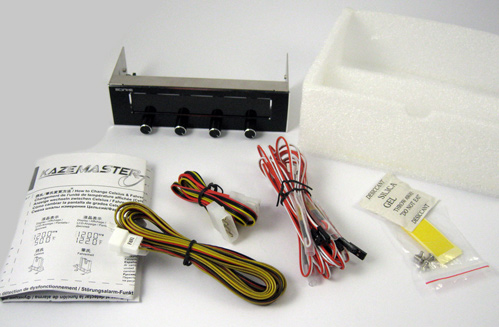
Our test Kaze Master ACE 5.25’’ sample is black although the device is available in silver color as well. Basically, the only difference is in the front panel. The panel is made of quality brushed aluminum.
The vacuum fluorescent display (VFD) is at the center of the panel and it displays letters and numbers in two shades of blue.
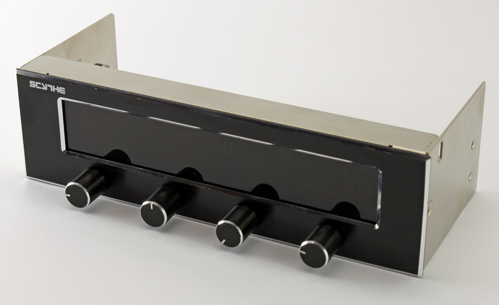
In practice, Kaze Master Ace 5.25’’ is quite a useful controller that not only professionals will benefit from. We’ve heard too many complaints on the noise levels of the fans in users’ cases and apart from changing the fans altogether, Kaze is your best shot towards relieving some of the noise at an expense of fan speed. Kaze Master Ace 5.25’’ can control up to 4 fans which will be enough in most cases. As you can see, each fan is equipped with one control regulator – twist it and set your preference, as simple as that.
RPM is displayed in the upper row whereas temperature readouts are in the row below. Temeperature and RPM readouts are independent of each other, and thanks to the long cables, no spot is out of reach.
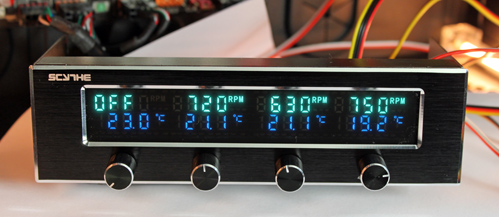
As you can see from the picture above, turning off a fan will display OFF in the screen, whereas an error would display a flashing 0. To further alarm the user of the error, the sound alarm will go off as well.
Display is 114mm long and 20mm high (4.49" x 0.79") which is enough for displaying four digit values.
Kaze Master Ace 5.25’’ will theoretically follow the fan from 0-9990 RPM in 30 RPM increments. Naturally, such values will hardly ever be seen in practice because each of the four fan channels will provide up to 12W. This means that if you use faster fans with over 3000 RPM, which usually require more than 12W, the controller will not be able to run them at maximum RPM. Note however that this is not a problem, as most users use standard fans with 12V and 1A which will be taken in stride by this controller. By turning the regulator on the controller, we provide from 3.7 to 12V to the fan, and thus directly affect the fan speed.
The following picture shows the back of the device, or PCB with resistors, chips, connectors, etc., to be more precise.
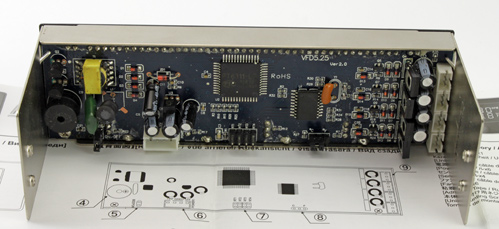
Starting from left, you’ll notice a Beep speaker which will sound if the fan stops or temperatures exceed 75°C. The speaker is numbered 4 on the diagram.
Number 5 on the diagram shows the ON/OFF jumper, which is used to turn sound alarms off (ON by default). Kaze Master Ace 5.25’’ has its power connector and is marked with 6.
Next in line are the two pin connectors for temperature sensors. As you can see from the picture, the device supports up to four heat-sensors with readings in °C or °F depending on the jumper position in the spot marked with 8.
The fan connectors are in a vertical row on the right. Scythe advises users to use 3-pin connector fans, because 4-pin (PWM) connector fans can cause the absence of or incorrect speed readouts.
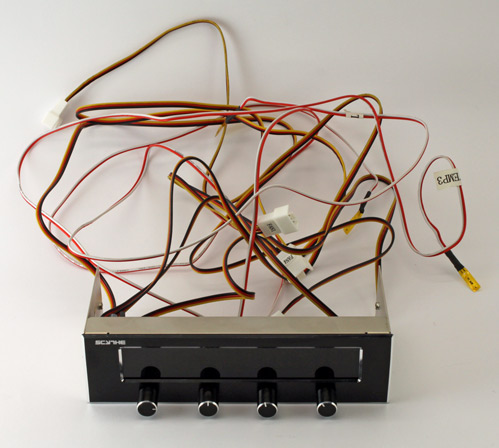
Specs
• Model Name:
Kaze Master Ace
• Model No.:
KM02-BK (5,25" black version)
• Measurements (W x H x D):
148.5 x 42.5 x 63 mm / 5.85 x 1.67 x 2.48 in
• Display Measurements (W x H):
114 x 20 mm / 4.49 x 0.79 in
• Length of the control dial:
12 mm / 0.47 in
• DC Input:
5 V or 12 V (From PC Power Supply Unit)
• Fan Adjustment Range:
3.7 V (±10%) ~ 12 V (±10%)
• Fan Channels:
4
• Maximum Ampere per Channel:
1 Ampere (= 12 W max.)
• Fan Speed Range:
0 ~ 9990 rpm (Display: 30 rpm steps)
• Number of Temp Channels:
4
• Temperature Range:
0 ~ 100°C / 32 ~ 199,9°F
• Measurement Frequency:
2 Seconds
• Weight:
165 g / 5.35 oz
Mounting Kaze Master ACE 5.25’’ in any of the free 5.25’’ slots is pretty easy. The following picture shows that the width is that of optical devices, meaning all you need to do is slide the controller in and fasten it with screws.
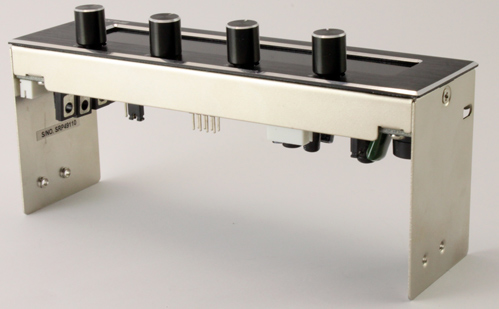
The following picture shows Kaze Master Ace 5.25’’ with CoolerMaster ATCS840.
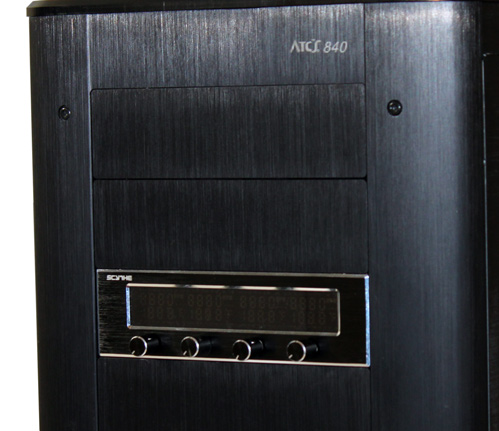
Most new cases use different 5.25’’ locking mechanisms in order to ease access to your components by not requiring tools. CoolerMaster ATCS840 uses push locking mechanism and it had no trouble with Kaze Master Ace 5.25’’.
Unfortunately, when we tried mounting the controller in our CoolerMaster Cosmos S case, we were quite surprised to see that it won’t fit into the 5.25’’ slot. The following picture shows that Kaze Master Ace went in for only a few mm before it got stuck, because the controller height (42mm) is higher than slots in Cosmos S case will allow (about 41mm).
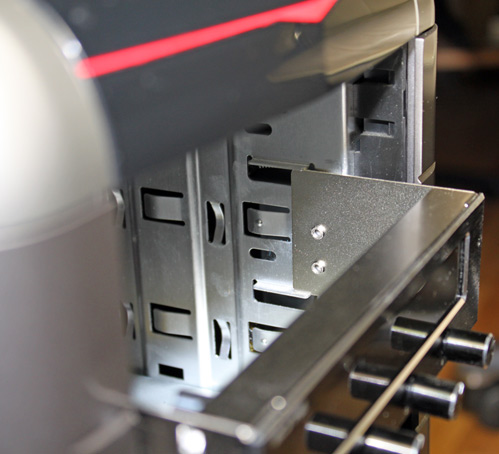
We solved this problem by placing the controller in the topmost 5.25’’ slot, where it would not be hindered by slot restrictions. We must admit that Kaze Master Ace 5.25’’ fit in quite nicely with the case, as you can see from the picture below.
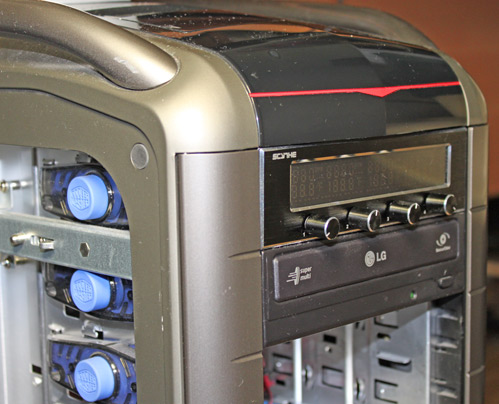
After testing the device with the new Corsair Obsidian 800D case, we found that the previous issue is not an isolated case. Luckily, only the bottom slot is a problem, whereas the rest 5.25’’ slots will take Kaze Master Ace without a hitch. Scythe probably didn’t think that anyone will try to save money on a few mm of steel, so they tailored their controller by most 5.25’’ slots.
The following picture shows the problem we had on Obsidian 800D case, where you’ll see that controller is stuck and refuses to go in.
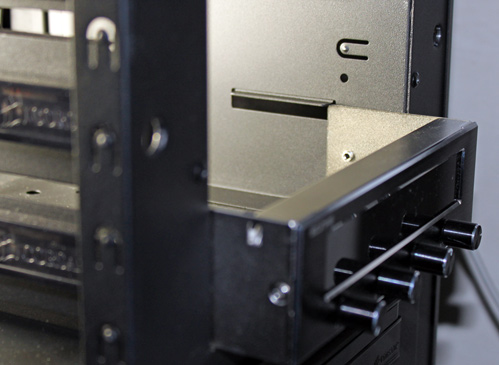
Obsidian 800D is special for its large front panel that’s over 2cm thick. Since the 5.25’’ slot sides are deep inside the case, Kaze Master Ace 5.25’’, with its 6.3cm sides, has trouble in reaching them. This means that problem is not fitting the controller but rather keeping it in place. However, firmly fastening the device with screws will do the trick.
The other way to keep the controller in the slot is to place it on the device in the slot below or, like we’ve done, place it in the slot below where the device will lay on the 5.25’’ cage lid. As we’ve already mentioned, this slot is tighter but the slot sides are deeper within the case, so Kaze Master Ace 5.25’’ barely touches them and is only a few mm away from being flush with the case. So, addressing this issue on Obsidian 800D is to place the controller in one of the higher slots and fasten it.
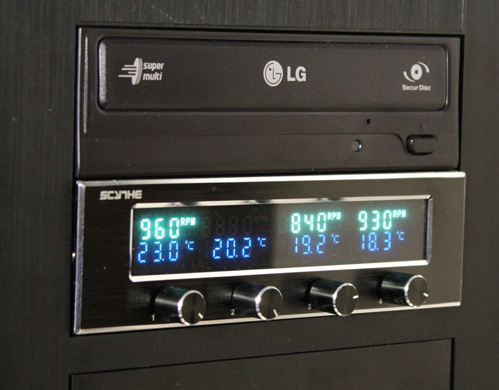
Temperature readouts make it easy to decide whether fan speed should be higher. If one of the fan-channels is empty, meaning if you didn’t connect the fan, the display will go blank. The same goes for temperature sensors.
If the fans stops due to an error, display will show a flashing 0 and if that’s not enough, the sound alarm will certainly alert you that there’s something wrong with your case.
We tested Kaze Master Ace 5.25’’ with fans in Obsidian 800D, CoolerMaster ACTS 840 and Cosmos S cases which took to controller commands instantly. We also tested with different 3-pin fans by Arctic Cooling, Gelid and Scythe, and they all ran flawlessly. We also tried it with two 4-pin (PWM) fans, one being Scythe’s Kama 4-pin (PWM) and the other Gelid Silent 12 4-pin (PWM).
Kaze Master Ace 5.25’’ read the rpm on Scythe Kama fan (which runs from 310RPM to about 1200RPM( whereas Gelid Silent 12 displayed up to 1350RPM. Although the former fan is rated up to 1500RPM, it’s still not that bad bearing in mind that Scythe doesn’t advise 4-pin fans for usage with this device.
The only problem we had with using PWM fans is at startup, and if the fan speed regulator on Scythe’s controller is set to OFF. In our scenario, the controller won’t detect PWM fans after starting the computer despite turning the regulator knob to ON and to 50%. It seems like the fan doesn’t get enough power to start with, so we had to provide higher voltage to PWM fans before they would even start. In contrast with the previous problem, if you turn the regulator to ON and provide sufficient voltage prior to starting up the computer, PWM fans would run from the start. This is great news, as the PWM fans, at least those that we tested, will run just fine, despite the fact that Scythe doesn’t advise them for this device.
Today we dissected Scythe Kaze Master Ace 5.25’’, a device whose primary goal is to make fan-speed regulation easy. Anyone can get wary of noisy fans, and thanks to Scythe, users are now capable of compromise where they can sacrifice thermals for silence the way they see fit. Kaze Master Ace 5.25’’ provides independent control over 4 fans with RPM readouts clearly displayed on the large VFD panel. The controller will take up to 4 heat-sensors with cables long enough to reach the farthest corners of your case if it’s required. Naturally, temperature readouts will be displayed on the screen as well.
Although this device has been on the market for over a year, Kaze Master Ace 5.25’’ is far from old. As you can see for yourself, its simplicity makes it a great addition to any case, and it’s compatible with almost any type of fan. The only thing to heed is that each of the 4 fan-channels support up to 12W maximum, but this will be more than enough for most users.
We must admit that this little device made our life much easier, and it introduces many benefits to anyone from seasoned pros to amateurs. The device enables monitoring temperatures and fan speed at all times, thus keeping tight reins on their pet, and if you ever change a case, bringing your little-big Kaze Master Ace 5.25’’ with you won’t be a problem. Kaze Master Ace 5.25’’ is a simple device that takes care of an important task, and we have no choice but to recommend it.
The Kaze Master Ace 5.25’’ is available in black and silver and you can find it priced at about €30, here.



